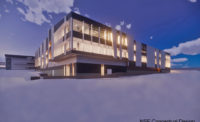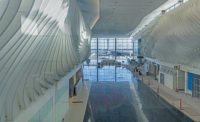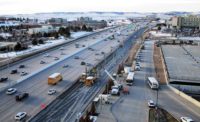DIA Kicks Off Renovation Of Jeppesen Terminal
“The Great Hall Project will reconfigure and better utilize the existing space in the terminal.”
– Kim Day, CEO, DIA
Denver International Airport officially broke ground on the three-and-a-half year renovation of its terminal this summer, an area known as the Great Hall. That is the area under the tent roofs of the terminal, which encompasses nearly 1.5 million sq ft. The project will make substantial improvements to Levels 5 and 6 of the terminal. The Great Hall Project is expected to create 400 to 450 construction jobs, more than 800 new permanent jobs and generate an additional $3.5 million in annual taxes. The project is intended to enhance security, provide a more flexible and open airline check-in space and add new dining and shopping options. It will also increase capacity of the terminal, update the aging facility and improve the overall passenger experience at DIA.
MKK Engineers Acquired By Midwest’s IMEG Corp.
Longtime Denver engineering firm MKK was recently acquired by consulting group IMEG from the Midwest. Founded in 1955, MKK specializes in high-performance design for new and existing facilities across many markets, including commercial, health care, education, hospitality, government, science and technology, and transportation. In addition to Denver, MKK has offices in Cheyenne; Billings and Helena, Mont.; and Salt Lake City. All offices have begun operating as IMEG. Based in Illinois, the company is one of the largest full-service engineering consulting firms in the U.S.
“By leveraging a broader base of markets and technical expertise, MKK/IMEG will be able to bring its Mountain States clients what IMEG brings to all its clients—the expertise of a national firm with the customer service of a local consultant,” said Paul VanDuyne, IMEG president and CEO.
Horrocks Engineers Expands Into Denver
Horrocks Engineers—a full-service engineering firm with more than 440 employees in 13 offices in Utah, Idaho, Nevada, Arizona, New Mexico, Washington and California—has opened its newest office in Denver.
John Holzwarth, branch manager of the new Denver office, has expertise in the transportation sector, including highways, bridges, airports, transit, rail, ports and maritime. He has expanded his management, leadership and delivery skills by serving clients and internal teams in an effort to deliver excellence in all aspects of the industry.
Feds Approve Next Phase Of Testing for RTD’s G Line
Denver’s Regional Transportation District recently received approval from the Federal Railroad Administration (FRA) to begin the next phase of testing on the G Line from Denver Union Station to Arvada and Wheat Ridge.
Testing has ramped up and soon will simulate the full daily service schedule of nearly 21 consecutive hours a day. Limited testing along the 11.2-mile line began last fall and has been underway between 8 a.m. and 6 p.m. on weekdays since the start of the year. That process has examined the communication signaling along the line as well as the effectiveness of the communication technology at each of the G Line’s 16 at-grade railroad crossings.
The gate-crossing technology is the same as that used along two additional lines originating in downtown Denver: the University of Colorado A Line to Denver International Airport and the B Line to Westminster.
When the G Line officially opens—a date yet to be determined—trains will run from 4 a.m. to 12:30 a.m., with 15-minute frequency between 6 a.m. and 6:30 p.m. and every 30 minutes during off-peak hours.
Pikes Peak Summit Complex Breaks Ground
The design team of RTA Architects of Colorado Springs (as architect of record) and GWWO Inc./Architects of Baltimore (as design architect) recently broke ground for the new Pikes Peak Summit Complex (PPSC). The facility will be constructed next to the current Summit House, which will remain open to visitors through the end of construction in 2020.
The new facility features rooftop terraces, dining, a gift shop and restrooms. The project exceeds the minimum goal of LEED Silver and is pursuing LEED Gold.
Colorado Capitol Receives National Design Award
The renovation of portions of the Colorado Capitol is among 15 outstanding building projects to receive a 2018 North American Copper in Architecture Award for its innovative design and creative use of copper. This year’s winners included educational facilities, residential dwellings, government buildings and religious structures.
As a result of the recent roof replacement on the 121-year-old Capitol, every piece of metal on the rooftop, from the standing seam panels to the shingles on the low-slope portions to the gutter is now copper. The goal of the renovation was to provide a one-of-a-kind roof for the historic building that would last for generations to come.
Colorado a Leader in Clean-Energy Jobs
More than 57,000 Coloradans work in clean energy in every county in the state, according to a new analysis of energy-jobs data released by the national nonpartisan business group E2 (Environmental Entrepreneurs).
Overall, clean energy jobs in the state grew slightly to 57,591, from 55,344, with energy efficiency leading the way with more than 32,000 jobs. Wind and solar energy combined for 15,000 jobs, powering renewable energy in Colorado to rank seventh among all 50 states and the District of Columbia.
According to the Clean Jobs Colorado report, about 10,000 clean-energy jobs can be found in the state’s rural areas while its three largest metro areas are home to nearly 43,000 clean-energy jobs. Denver County led all counties in the state with 11,000 jobs at the end of last year. Arapahoe, Jefferson, El Paso and Adams counties followed with more than 5,000 jobs, with Boulder County falling just short, at 4,940.
DIA Passenger Bridge Marks 25th Anniversary
This summer, Denver International Airport celebrated the 25th anniversary of its iconic pedestrian bridge, one of only two of its kind in the world. The bridge connects the terminal with Concourse A, houses a TSA security portal on its lower deck and an international customs area accessed on the upper level. Built in 1993 to offer a pedestrian alternative to the airport’s inter-terminal train system, the bridge was widely acclaimed at the time as the longest free-span airport bridge in the U.S. However, it was not originally included in the airport’s master plan. It was added after the terminal and Concourse A already had been constructed. Construction took less than 12 months. The 40-ft-wide, 365-ft-long passenger bridge was designed by LOA Architecture (previously Luis O. Acosta Architects). Other design team members included the structural engineer and prime consultant LONCO (now operating as Benesch), mechanical engineer Behrent Engineering and electrical engineer Roos/Szynskie. The contractor was M.A. Mortenson Co.






Post a comment to this article
Report Abusive Comment